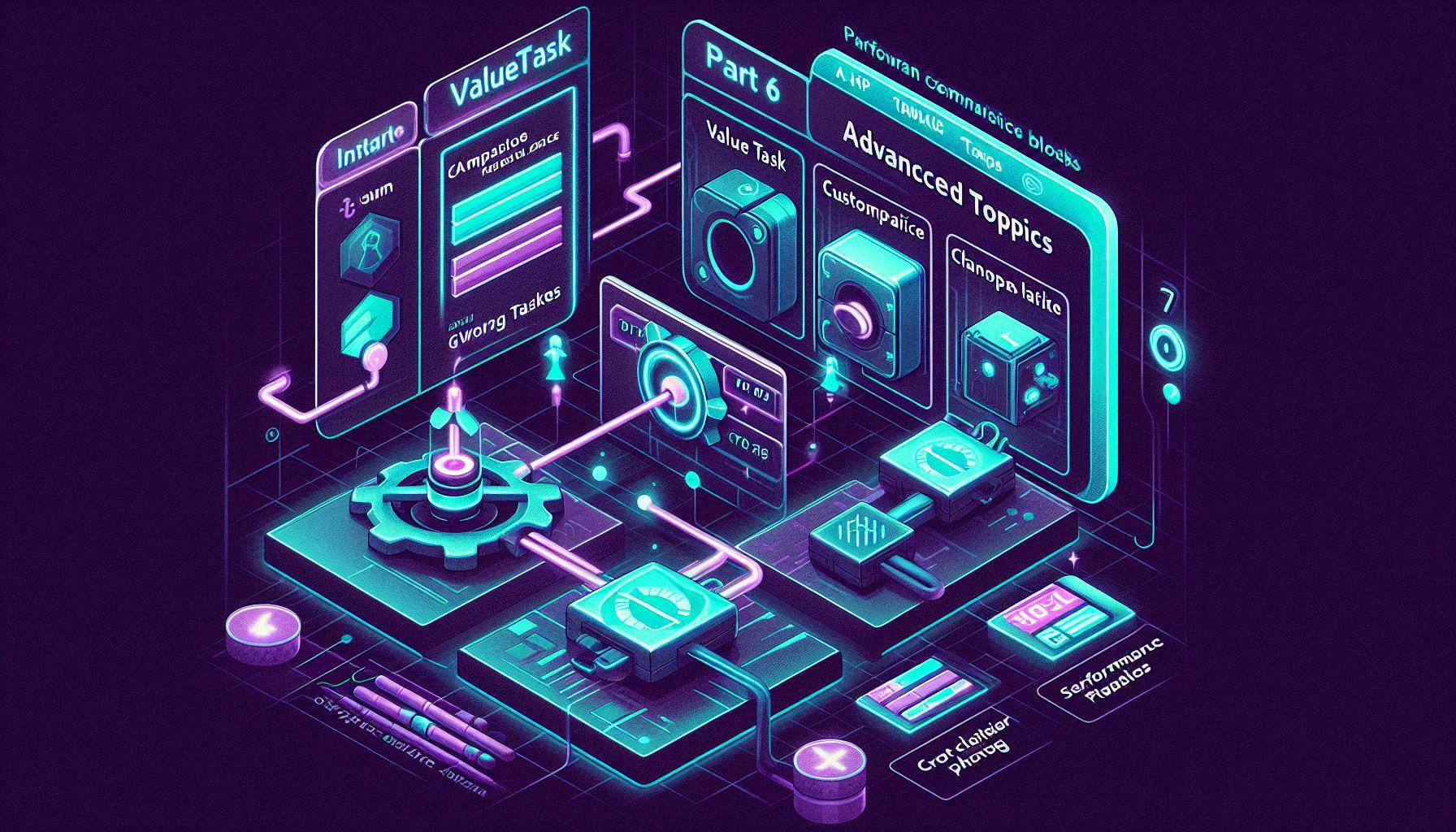Mastering Asynchronous Programming with C# async/await - Part 6: Advanced Topics

Part 6: Advanced Topics
Now that we’ve mastered the basics and patterns, let’s go further into advanced async scenarios you’ll meet when optimizing throughput or designing libraries.
ValueTask vs Task
Task is a reference type allocated on the heap. In ultra‑hot paths where many calls complete synchronously, ValueTask can save allocations.
public async ValueTask<int> GetNumberAsync(bool cached)
{
if (cached) return 42; // completes synchronously (no allocation)
await Task.Delay(1000); // completes asynchronously
return 42;
}
Guidelines
- Prefer
Taskby default (simpler, safer). - Consider
ValueTaskwhen profiling shows allocation pressure and many sync completions. - Don’t await a
ValueTaskmore than once and don’t store it; convert toTaskvia.AsTask()if you must pass it around.
Custom Awaiters (rare, but educational)
Anything with a GetAwaiter() that returns an awaiter implementing INotifyCompletion (or ICriticalNotifyCompletion) is awaitable.
public sealed class DelayAwaitable
{
private readonly int _ms;
public DelayAwaitable(int ms) => _ms = ms;
public TaskAwaiter GetAwaiter() => Task.Delay(_ms).GetAwaiter();
}
// usage
await new DelayAwaitable(250);
Console.WriteLine("custom awaiter resumed");
When would you do this?
- Domain‑specific scheduling/timing semantics.
- Interop layers.
Most apps never need it; understanding it helps you reason aboutawait.
Async Coordination Primitives
Limit concurrency with SemaphoreSlim
var gate = new SemaphoreSlim(3); // allow 3 concurrent ops
async Task ProcessAsync(string item)
{
await gate.WaitAsync();
try
{
await DoWorkAsync(item);
}
finally
{
gate.Release();
}
}
Use this to throttle IO‑heavy fan‑out work (APIs, disk, DB) and avoid overloading dependencies.
Pipelines with Channel<T>
System.Threading.Channels enables high‑throughput producer/consumer pipelines.
var channel = Channel.CreateUnbounded<string>();
// producer
_ = Task.Run(async () =>
{
foreach (var url in urls)
await channel.Writer.WriteAsync(url);
channel.Writer.Complete();
});
// consumer(s)
await foreach (var url in channel.Reader.ReadAllAsync())
{
var html = await client.GetStringAsync(url);
Console.WriteLine($"{url} -> {html.Length} bytes");
}
Channels support backpressure (bounded channels), multiple consumers, and graceful completion.
Performance Tuning Checklist
- Avoid unnecessary
Task.Runin ASP.NET Core — IO work should be awaited;Task.Runis for CPU‑bound work that you explicitly want off the request thread. - Batch awaits with
Task.WhenAllto reduce continuation overhead when independent operations can run together. - Use
ConfigureAwait(false)in libraries/background services to skip context capture. (In ASP.NET Core there’s no synchronization context, but it still avoids overhead.) - Minimize layers of trivial
asyncwrappers; if you just return a task, you may not needasync/awaitat that layer. - Pool and reuse expensive objects correctly (e.g., reuse
HttpClientviaIHttpClientFactory). - Measure first with a profiler (allocs, context switches, contention) before micro‑optimizing.
Debuggable, Defensive Async
- Prefer cancellable APIs: accept a
CancellationToken. - Use timeouts where appropriate to avoid stuck requests.
- Add structured logging around awaits (operation name, correlation IDs).
- In fire‑and‑forget scenarios, capture and log exceptions inside the launched task.
Key Takeaways
ValueTaskcan reduce allocations in hot paths; default toTaskotherwise.- Custom awaiters are a niche but deepen understanding of
await. SemaphoreSlimandChannel<T>are your go‑to tools for concurrency control and pipelines.- Tune with evidence: profile, batch awaits, and avoid unnecessary context capture.
👉 In Part 7, we’ll wrap up with testing and debugging async code: async unit tests, mocking, Visual Studio’s async tools, and tracing async flows.
Series Navigation
Previous: Part 5 – Real-World Use Cases Series Index: Overview Next: Part 7 – Testing & Debugging